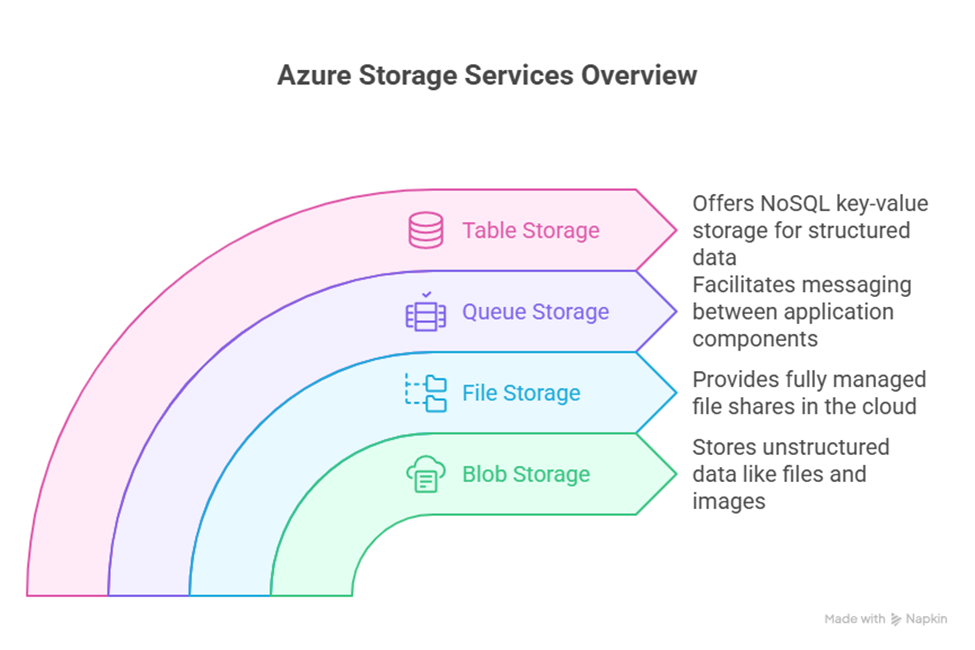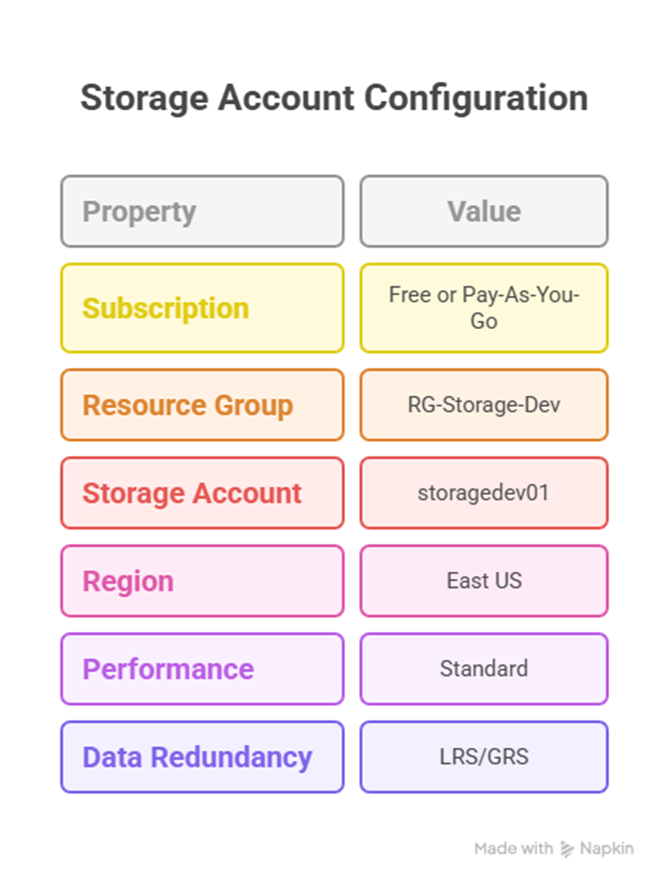Introduction
Azure Storage is the foundation for building scalable, secure, and high-performance cloud applications. Whether you are storing unstructured files, structured tables, messages for processing, or shared files, Azure Storage offers tailored services.
At curiositytech.in, we emphasize learning by hands-on experimentation, allowing learners to explore storage options in real projects. This blog covers all mandatory details of Azure Storage, comparing Blob, File, Queue, and Table storage, along with use cases, best practices, and tips for experts.
1. Overview of Azure Storage Services
Azure Storage provides four main types of storage services:
| Storage Type | Purpose | Key Features | Use Case Example |
| Blob Storage | Store unstructured data (files, images, videos) | Tiered storage, replication, versioning | Hosting website images, backups |
| File Storage | Fully managed file shares in the cloud | SMB/NFS access, snapshot support | Shared drives for enterprise teams |
| Queue Storage | Messaging between application components | Reliable FIFO message delivery, scalable | Decoupling microservices |
| Table Storage | NoSQL key-value storage for structured data | Schema-less, fast access, low cost | Storing IoT sensor data, logs |
Diagram: Azure Storage Architecture

2. Azure Blob Storage: Unstructured Data Storage
- Definition: Blob Storage is designed to store any type of unstructured data.
- Types of Blobs:
- Block Blobs – Ideal for text or binary files, supports large file uploads
- Append Blobs – Optimized for append-only workloads (logs)
- Page Blobs – Used for random read/write operations (VHDs)
- Block Blobs – Ideal for text or binary files, supports large file uploads
Practical Use Case:
A media company stores video content in Blob Storage, leveraging hot, cool, and archive tiers to optimize cost based on access frequency.
Tip: Always define the correct access tier during deployment to reduce storage costs.
3. Azure File Storage: Shared File Access
- Definition: Fully managed file shares accessible via SMB or NFS protocols.
- Benefits:
- Centralized file access
- Integrates with Windows/Linux environments
- Snapshots for point-in-time recovery
- Centralized file access
Practical Example:
Teams in a corporation share a directory of project documents via Azure File Share. Developers can mount the share directly on their machines as a network drive.
4. Azure Queue Storage: Decoupled Messaging
- Definition: Provides reliable, scalable message queuing for cloud applications.
- Key Features:
- FIFO message delivery
- Supports large-scale applications
- Helps decouple microservices for better reliability
- FIFO message delivery
Scenario:
An e-commerce application uses queues to process orders asynchronously. The frontend pushes order messages to the queue, and backend services process them independently, ensuring system resilience during high traffic.
5. Azure Table Storage: Structured, NoSQL Storage
- Definition: Table Storage is a schema-less, key-value storage for structured data.
- Advantages:
- High-speed lookups
- Cost-effective for massive datasets
- Supports large-scale telemetry and logging
- High-speed lookups
Use Case Example:
IoT sensors send millions of telemetry events per day. Table Storage stores this structured data efficiently, allowing fast queries by device ID or timestamp.
6. Comparative View: Choosing the Right Storage
| Storage Type | Best For | Access Method | Performance Tier |
| Blob | Files, images, backups | REST API, SDK, AzCopy | Hot, Cool, Archive |
| File | Shared directories | SMB/NFS | Standard / Premium |
| Queue | Messaging between apps | REST API, SDK | Standard |
| Table | Structured NoSQL data | REST API, SDK | Standard |
7. Hands-On Example: Creating a Storage Account
1 .Navigate to Azure Portal → Create Resource → Storage Account
2. Fill Basic Info:
- Subscription: Free or Pay-As-You-Go
- Resource Group: RG-Storage-Dev
- Storage Account Name: storagedev01
- Region: East US
- Performance: Standard
- Resource Group: RG-Storage-Dev
Redundancy: LRS/GRS based on requirements
3. Review + Create
4. Practical Tip: Use Azure CLI or PowerShell for scripting repetitive storage tasks. For

8. Expert Tips to Become an Azure Storage Specialist
- Understand tiering options (hot, cool, archive) and their pricing impact.
- Learn storage replication strategies: LRS, GRS, RA-GRS for durability.
- Automate backups and snapshots using Azure Backup and Storage Explorer.
- Explore Azure Storage security: Shared Access Signatures (SAS), RBAC, encryption at rest.
- Combine storage services in real projects to simulate enterprise scenarios (e.g., Blob for media, Queue for tasks, Table for logs).
At curiositytech.in, learners get structured labs to deploy, manage, and optimize all Azure storage services, ensuring practical expertise.
Conclusion
Azure Storage services are the heart of cloud applications, providing scalable, secure, and versatile options for every type of data. Understanding Blob, File, Queue, and Table storage and using them strategically allows cloud engineers to build robust, cost-effective, and enterprise-ready solutions. With hands-on guidance from curiositytech.in, beginners can progress to expert-level storage management confidently.



